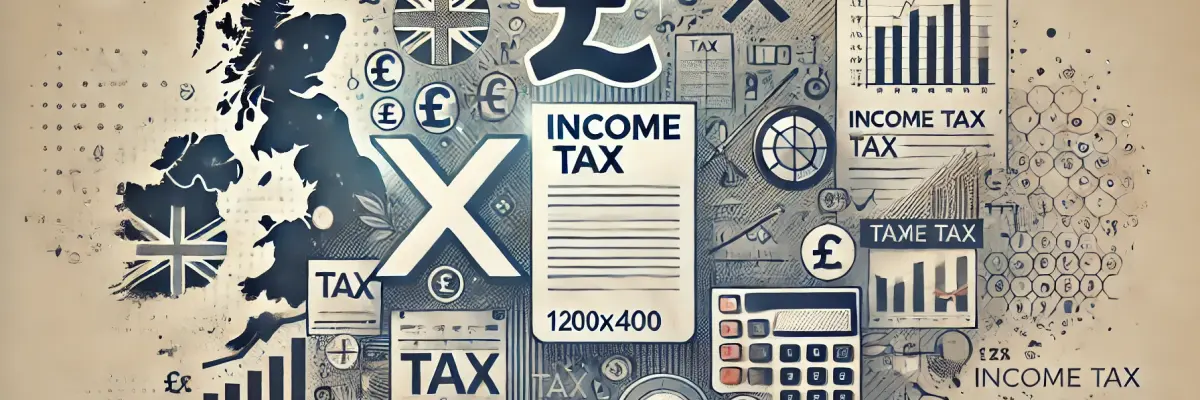Income Tax
- Lee Wisener
- 13-10-2024
- Tax Guides
Income Tax is something virtually all of us pay in our lifetime. It's the most common, inescapable tax. This guide gives a basic overview of what it is and how it's calculated, and at the end of it, you will understand it better.

Table of contents
The Joy of UK Income Tax: A Lighthearted Guide to the Dreaded Deduction
Ah, income tax – that little slice of your hard-earned money that you generously donate to keep the country ticking. It’s the financial equivalent of eating your greens: necessary, nourishing (for society), and often accompanied by a grimace. Whether you’re in Scotland or England, the taxman cometh, and he’s got his calculator ready. But worry not! I'm here to guide you through the maze of UK income tax with a smile, a chuckle, and maybe even a sigh of relief.
What is Income Tax, Anyway?
Income tax is like that unwanted guest at your financial party – it always shows up, takes a chunk of your money, and then leaves you wondering what just happened. Simply put, it’s a tax on the money you earn. This includes your salary, bonuses, and even that £5 you won in the office sweepstake (sorry to break it to you), but I doubt HMRC will come after you for a slice of that. Well, unless your colleagues are not happy about your win!
The UK government uses this money to fund public services like the NHS, education, and those delightful roadworks that always seem to spring up at the most inconvenient times, like when you set out to drive any distance. So, while paying income tax might feel like feeding a pet that never stops growing, it’s keeping the country running smoothly. Or at least, that’s the idea.
The Difference Between England and Scotland: A Tale of Two Tax Codes
If you thought income tax was confusing, wait until you realize it’s calculated differently depending on whether you’re in England or Scotland. Yes, we have our own unique system north of the border, so why not add a bit of variety to the mix?
Examples of tax payable
Let's assume an income of £150,000, mainly because it's a nice round number and includes all tax bands to show the complete picture. But I get it: most of you earn more than this right?
For England, it's relatively straightforward with 4 tax bands. Tax paid represents 35.76%.
| Tax Band | Income Range | Tax Rate | Tax Payable |
|---|---|---|---|
| Personal Allowance | £0 - £12,570 | 0% | £0 (Not Applicable) |
| Basic Rate | £0 - £37,700 | 20% | £7,540.00 |
| Higher Rate | £37,701 - £125,140 | 40% | £34,988.00 |
| Additional Rate | £125,141 - £150,000 | 45% | £11,117.55 |
| Total Tax Payable | £53,645.55 |
Scotland decided that the English system wasn’t quite complex enough, so they added a few more layers. It’s like turning your hill climb into a mountain trek. Tax paid represents 38.31%.
| Tax Band | Income Range | Tax Rate | Tax Payable (£) |
|---|---|---|---|
| Personal Allowance | £0 - £12,570 | 0% | £0 (N/A) |
| Starter Rate | £0 - £14,732 | 19% | £2,799.08 |
| Basic Rate | £14,733 - £25,688 | 20% | £2,191.00 |
| Intermediate Rate | £25,689 - £43,662 | 21% | £3,774.33 |
| Higher Rate | £43,663 - £75,000 | 42% | £13,961.54 |
| Top Rate | £75,001 - £125,140 | 45% | £22,562.55 |
| Additional Rate | Above £125,140 | 48% | £11,932.80 |
| Total Tax Payable | £57,221.30 |
Sure, most people in the UK are not even close to these income levels. This is simply to show all the tax bands and allow me to whine more about paying more tax in Scotland.
It's a progressive tax system
Across the UK, income tax is paid on a progressive basis. That is, you earn more, and you pay more.
Personal Allowance
Everyone starts with a personal allowance of £12,570. That means that all earnings up to that level are not taxed, so you can earn up to this amount and pay no income tax. Yay! Wait that is barely enough to cover gas and electricity these days. Sigh.
If you earn enough, you won't even get the personal allowance. For every £2 above £100,000, the personal allowances start to reduce by £1. Essentially, this means that if you earn £125,140, you get no personal allowance at all. That is why the tables above show the personal allowance as not applicable, as both use an income of £150,000. And poof! Now you pay tax on every penny.
There is some opportunity to reduce your tax liability with other allowances. For example:
- Marriage Allowance: If you’re married or in a civil partnership, you can transfer 10% of your Personal Allowance to your partner, provided they’re not a higher rate taxpayer. It’s the government’s way of saying, “Thanks for putting up with each other.”
- Pension Contributions: Paying into a pension not only secures your future but also reduces your taxable income. It’s like killing two birds with one stone, except the birds are your financial worries.
- Charitable Donations: the government gives you a little tax relief if you donate to charity. It’s a win-win – you get to feel good about helping others and save a bit on your tax bill.
Understanding UK Tax Codes: The Mystery Decoded
Tax codes in the UK might look like secret messages from the tax office, but they’re just a way to determine how much of your income gets taxed. Think of your tax code as a sort of financial shorthand that tells your employer how much money to leave in your pocket before the taxman comes knocking.
A tax code is a mix of numbers and letters determining how much tax-free income you’re entitled to each year. The numbers represent your tax-free Personal Allowance, and the letters? Well, they add a little extra context, like footnotes, but for your finances.
Let’s look at a typical tax code: 1257L.
- Numbers (1257): This number isn’t just there to look official. It tells you that you can earn £12,570 tax-free this year. Just multiply the number by 10, and voilà, there’s your Personal Allowance.
- Letter (L): The letter in your tax code is like a status update for HMRC. The L here means you get the standard Personal Allowance, no surprises.
Common Tax Code Letters and What They Mean
- L: You’re getting the standard Personal Allowance. Lucky you!
- M: Your spouse has been generous and transferred 10% of their Personal Allowance to you (Marriage Allowance).
- N: You’ve returned the favor and transferred 10% of your Personal Allowance to your spouse.
- T: Your tax code has some extra calculations because of things like benefits or underpaid tax from a previous year.
- 0T: No Personal Allowance for you! This happens when your income is high, or your new employer doesn’t know your tax code yet.
- BR: All your income is taxed at the basic rate (20%). This often happens if you have more than one job or pension.
- D0: You’re taxed at the higher rate (40%) on all your income, usually if you have a second job or pension.
- D1: You’re in the top tier, taxed at the additional rate (45%) on all your income.
- K: This is a bit of a twist—your allowances are less than what you owe, often because of benefits from your employer or other untaxed income.
If you ever find yourself with a tax code that includes 1257L W1/M1 or something similar, you’re on an emergency tax code. It’s like getting stuck in a holding pattern at the airport—you’re temporarily taxed more than usual until HMRC sorts things out. Each payday is treated in isolation, so you might see more tax taken out than expected until your code is corrected.
Tax codes might look complicated, but once you break them down, they’re just a tool to help ensure the right amount of tax is taken from your income. Understanding your tax code can help you avoid any unexpected bills (or refunds) from HMRC at the end of the tax year. And if you’re ever unsure, a quick call to HMRC can clear things up—no code-breaking skills required!
Order matters
Calculating income tax can seem a bit like juggling multiple balls—pension contributions, perks, and national insurance all play a role. Let’s break down the process step-by-step, so you can see exactly how it all fits together.
First things first: you start with your gross income. This is the total amount of money you earn before any deductions, including salary, bonuses, and any other earnings.
Example: Let’s say you have a gross income of £50,000.
If you contribute to a pension scheme, your contributions can reduce your taxable income. These contributions are typically taken from your salary before tax is calculated.
- Workplace Pensions: If your pension contributions are taken via a salary sacrifice scheme (common in workplace pensions), your gross income is reduced by the amount of the contribution before any taxes are calculated.
- Personal Pensions: If you contribute to a personal pension, you may need to claim tax relief separately, depending on the type of pension.
Example: If you contribute £5,000 to a pension via salary sacrifice, your taxable income is reduced to £45,000.
Next, you apply any tax-free allowances you’re entitled to, such as the Personal Allowance. As mentioned earlier, the standard Personal Allowance for most people is £12,570, but it decreases if your income exceeds £100,000.
Example: With a taxable income of £45,000, you subtract the Personal Allowance of £12,570, leaving you with £32,430 of taxable income.
Now, you apply the appropriate tax rates to the remaining taxable income based on the tax bands. In Scotland for example your tax would be.
| Tax Band | Income Range | Tax Rate | Taxable Income | Tax Payable |
|---|---|---|---|---|
| Personal Allowance | £0 - £12,570 | 0% | £12,570 | £0 |
| Basic Rate | £12,571 - £50,270 | 20% | £19,860 | £3,972 |
| Higher Rate | £50,271+ | 40% | £0 | £0 |
| Total Tax Payable | £3,972 |
Note that unlike our previous examples, the income is low enough to benefit from the personal allowance.
If you receive perks from your employer, like a company car or private medical insurance, these are known as benefits in kind and are usually subject to income tax. The value of these perks is added to your taxable income, increasing the amount of tax you pay.
Example: If your company car is valued at £5,000 for tax purposes, this is added to your taxable income. Now, your taxable income would go back up to £50,000.
So just to make it clear, the order of calculation when it comes to tax would look something like this:
- Gross Income
- Subtract Pension Contributions (if via salary sacrifice)
- Apply Personal Allowance (and other allowances)
- Calculate Income Tax (apply to taxable income)
- Add Benefits in Kind (perks like a company car)
- Calculate National Insurance Contributions (on gross income minus pension)
- Deduct Income Tax and NICs from gross income to get net income
Summary
Okay, that was as simple as I could make it. There is a lot to take in but for most of us that covers the main elements of calculating income tax. Oh but wait, we're not done yet. National insurance! It's also got to be deducted, I slid it into the list above at point 6 but that is a topic on its own and that is what is coming next. Bet you can't wait!
Lee Wisener
I am the Admin of this site. I created it from scratch, and I made all the content. The bottom line is that I'm it if you're looking for the person responsible! We now have a new support system, please log in and use it rather than email where possible.



Comments (0)
Want to comment on this page? Login or Register.